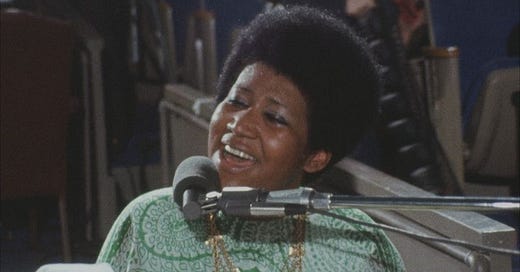Amazing Grace

A beautiful face, covered in sweat, eyes shut, belting out a song that lifts everyone’s spirits and knocks everyone back into their seats at the same time. Nothing fancy with the camerawork, just capturing one of the great voices in her element.
Eight months after the death of one of the great voices in any genre of music, the Aretha Franklin gospel concert film Amazing Grace is finally on the big screen. Music and film are all the better for it.
At the height of her popularity, Franklin told her label Atlantic Records that she wanted to record a gospel album, which would turn out to be Amazing Grace. It would become Aretha’s biggest selling album of her career and the biggest selling live gospel album ever. Director Sydney Pollack (This was after They Shoot Horses, Don’t They? and before Jeremiah Johnson) and his crew were going to film the recording, which would take place inside the Temple Missionary Baptist Church in Watts over the course of two evenings.
Sadly, the film and the sound did not synch up and the project was shelved by Warner Brothers. Thanks to the power of digital technology, the film has been restored. I hope there are a slew of special features on the film’s video release (Dear Criterion…) because that story will be a riveting one as well. Apparently, Franklin threatened several film festivals from showing the film while she was alive.
That’s a mystery worth its own film.
Franklin, who barely speaks in the film, lets the music do the talking. The film is not flashy and all the better for it. It’s Aretha and the church’s world and the cameras are just visiting.
Some of the musical highlights include the title track, Marvin Gaye’s “Wholy Holy,” a combination of “Bridge Over Troubled Water” and “You’ve Got a Friend,” “How I Got Over” and “The Old Landmark,” known by film fans as the song James Brown performs in The Blues Brothers.
As is Franklin wasn’t enough, there’s also the Southern California Community Choir (great faces!) under the direction of Alexander Hamilton bringing their own gospel punch. As does the Rev. James Cleveland and Franklin’s father, the Rev. C.L. Franklin, who makes an appearance and has a few words.
The camerawork isn’t always perfect, but that’s part of the film’s charm. Yes, you see several times camera operators in shots and/or moving. Trying to film in the aisles, around the musicians and trying not to get stepped on when dancing begins on the floor. There are a few moments of “will the image come into focus.” Everybody has one, maybe two takes on a song so the stakes are high. The film even shows when everything pauses because a cup of water is spilled.
Usually footage of the audience is unnecessary, but seeing a combination of those absolutely lost in the music and those just looking directly into the lens adds to the guerilla aspect of the filmmaking. If you look closely, you can see Mick Jagger and Charlie Watts in attendance. There are also several amusing moments of director Pollack, clapping along to the music or point to cameramen with a “film that” look.
Upon the official release, a long-awaited holy grail of cinema is finally discovered. It has already been put in the same stature of other essential concert films like Stop Making Sense and The Last Waltz. It lives up.
Amazing Grace is a must-see for Aretha fans and for fans of music as a whole. Anyone who watches the talents TV contests owe themselves to see this film. Aretha Franklin was one who wailed with purpose, not just holding vowels for the sake of it. When it comes to vocals powers, Aretha Franklin has returned from the dead in cinematic form and says to the world “hold my beer.”
Matthew Socey is host of Film Soceyology for WFYI 90.1 FM and wfyi.org in Indianapolis.


